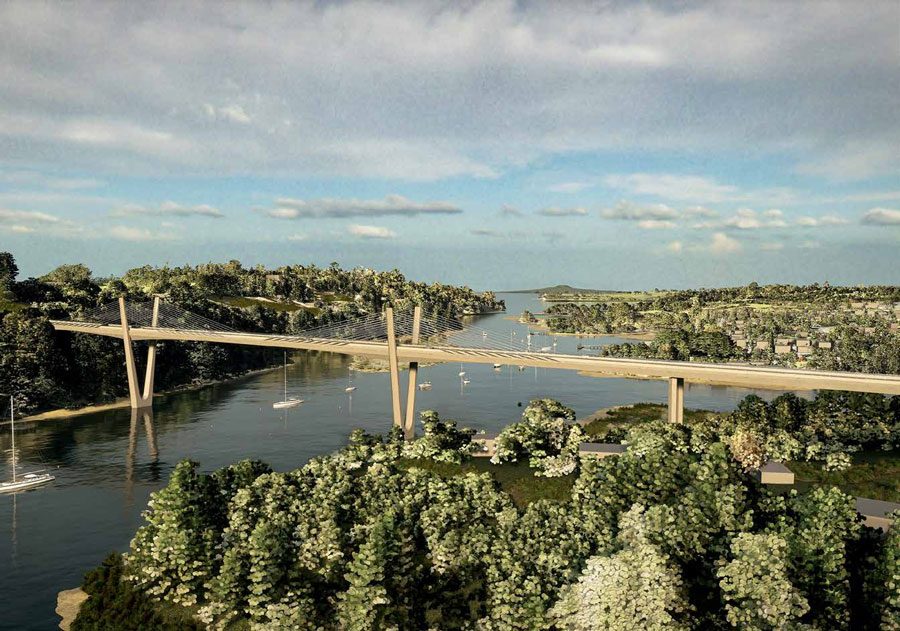

It’s an overlooked, quiet, and quite beautiful waterway right close – surprisingly so – to Auckland. Me old shipmate Tony and I decided to go take a better look at the Weiti River from Stillwater to Silverdale, while other yachts and launches sailed right past it.
I’ll be in trouble if I continue writing this, for the good folk of Stillwater Boating Club don’t necessarily want their secret out. But I’ll do it anyway. This is an Up the Creek adventure that needs to be much better-known. For it’s so close to the boating bustle of Auckland’s Waitematā Harbour and the inner Hauraki Gulf – but as the name Stillwater implies, it offers quietude and escape in equal measure. And a fine haven for boats of all kinds. For once the billing rings true. But things might change. So check it out quick.
It was also for us an Up the Creek that offered three adventures in one. First, we did our exploring on the water; and we found out about a classic Kiwi boating club to add to our list of profiles; and then we continued testing the clever Savvy Navvy smartphone app. It sounds like we were super busy, but no, the vibe of the whole weekend was super cool and laid-back. But with some surprises too – like an unexpected shipwreck! Every Up the Creek needs one I reckon… I did my research and planning – including taking a close look at Google Maps aerial photos and The Savvy Navvy charts of the Weiti River. I figured we could get a long way up, right to the road bridge at Silverdale in the rubber dinghy. Turns out we could have done it most of the way in Skyborne, our 12m cruising cat, too – as the famous boatbuilders Fusion Marine (of similarsized catamarans) have their yard and slipway up there at Manga Road. At high tide of course.
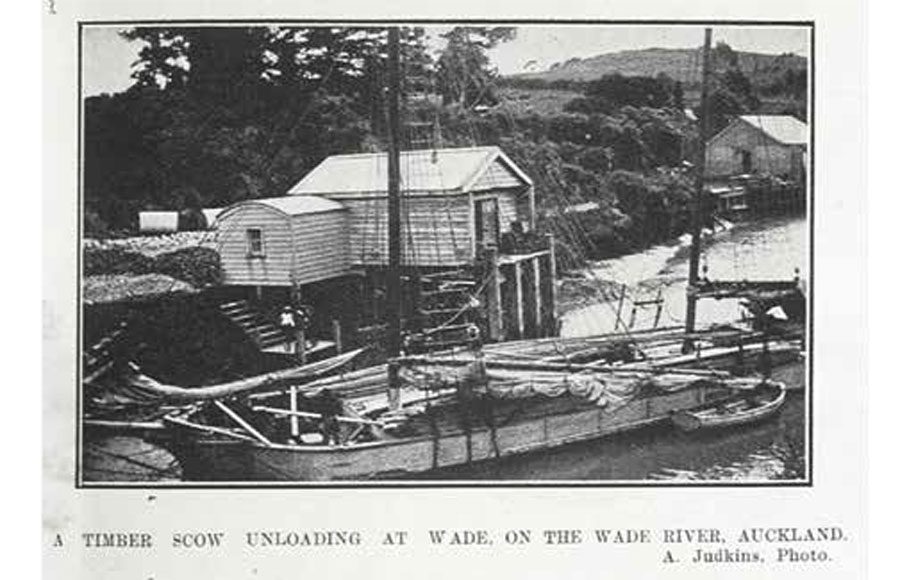
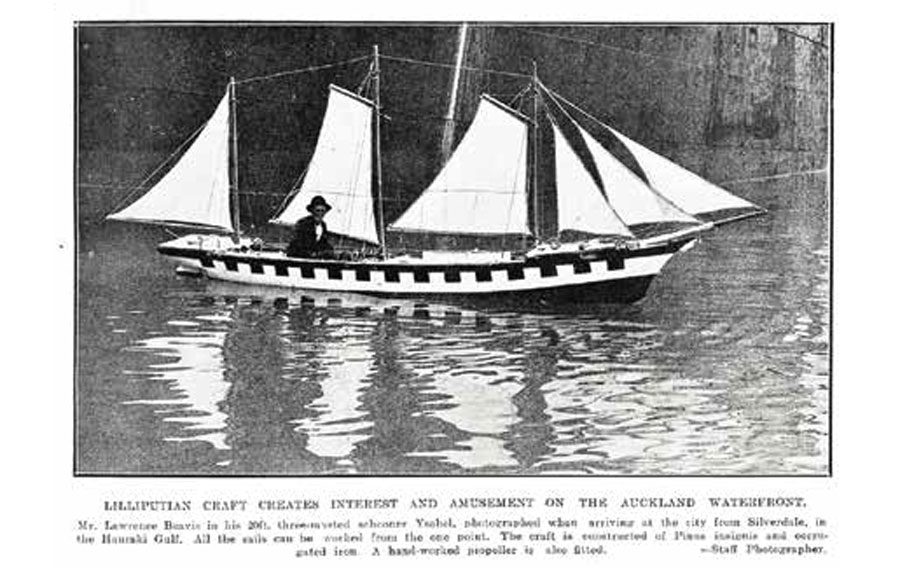
The creek is obviously still being used for travel, as someone had made much effort to clear the channel of many huge trees (mostly radiata pines) that had fallen across it in recent storms. What hard yakka it must have been to chainsaw the trunks from a floating base and to remove all the debris timber! Turns out it was the harbourmaster wot done it – and it wasn’t a cheap operation either – around $70,000 is the word on the waterway. Thanks! It made for a wide and easy path for us in the little dinghy. And for the continued comings and goings from the Fusion Boats yard too. Speaking of small boats, the equally famous racing dinghy builder Mackay Boats is also based up there. Though I’m sure its boats leave the premises by trailer.
Despite its current quiet ambience, this Up the Creek has an air of imminent great change about it. The little settlement of Stillwater has for many years been quite remote. It has no shops. Indeed the only place for a meal there is the Stillwater Boating Club, so it has become one of the community’s natural hubs. And very fine meals they are too. The Pulled Pork Bun is a standout on the menu. Our compliments to Chef Nicky!
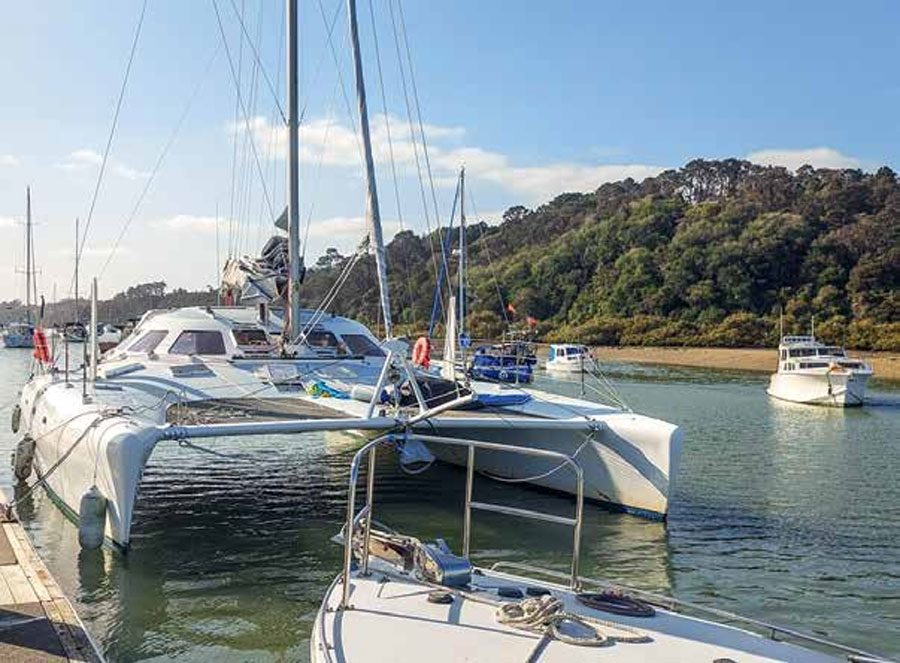

LOST WORLD
The ‘lost world’ feel of Stillwater is because it lies separated from the expanding sprawl of the North Shore suburbs of Auckland by an extensive historical farm, the Weiti Station, and the large area of the Okura Bush, both bounded on their southern side by the deep inlet of the Okura River estuary and Long Bay Regional Park. Together the farm, park, river and block o’ bush have provided a natural blue-green boundary limit to further expansion of the city.
But a planned diagonal shortcut through this land, a major road and even more impressive, high flyover bridge crossing the Weiti River, leading from State Highway 1 just north of Redvale to the Stanmore Bay area halfway along the Whangaparāoa Peninsula will change all this. The O Mahurangi-Penlink will make Stillwater way more accessible by land, by means of an offramp leading to Duck Creek Road. Find out more about the development on the Waka Kotahi website (see info panel).
O Mahurangi-Penlink will also make the Weiti Boating Club, which lies on the NE shore of the Weiti River and a bit downstream from Stillwater, more accessible by road.
But Tony and I are avowedly arriving by boat. That’s the purpose of an Up the Creek Adventure after all.
Approaching the inlet means a deep diversion from the course most boats take around the tip of the Whangaparāoa Peninsula for getting out into the Hauraki Gulf, or heading to Kawau Island.
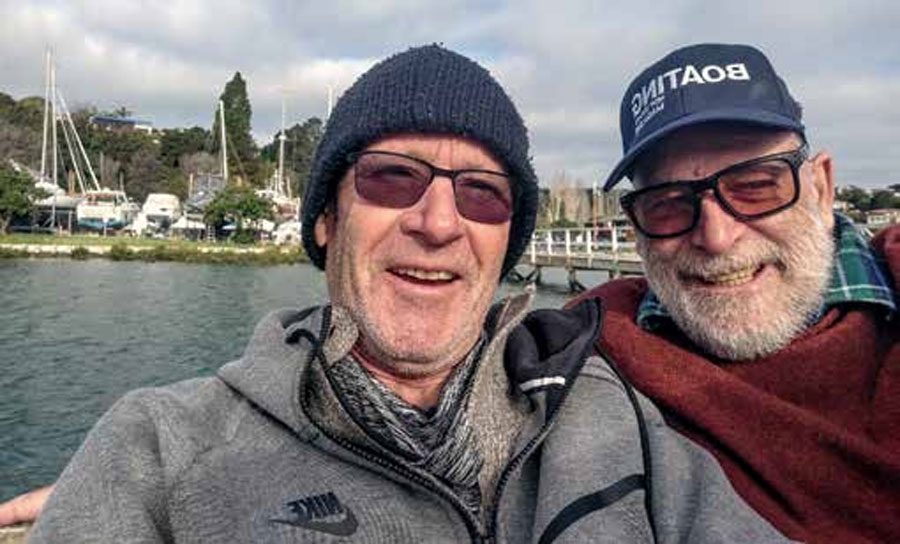
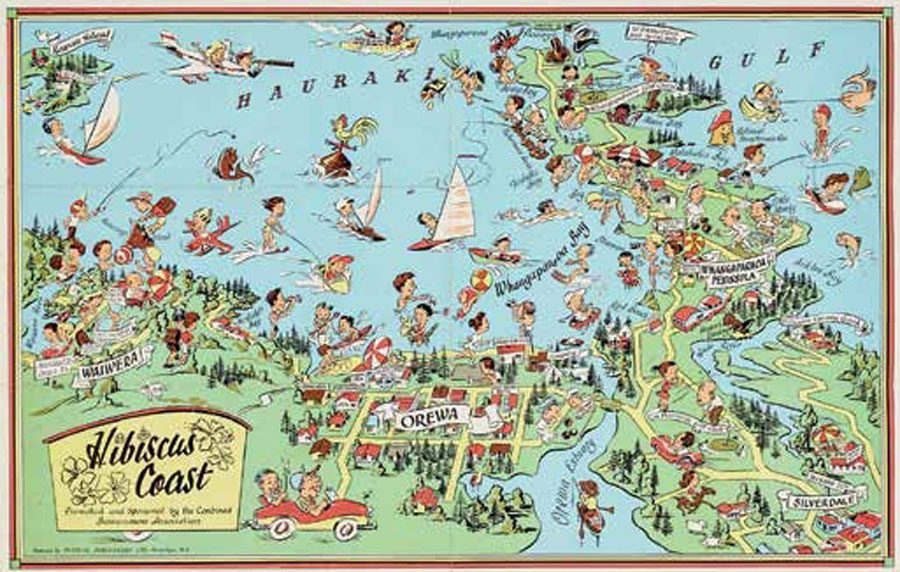
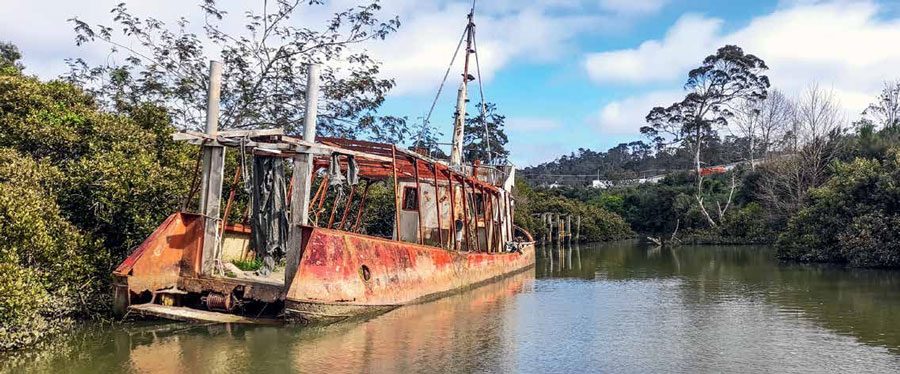
There’s history here: The northern side of the Okura River was known as Otaimaro, the location of a big Māori kāinga and pā.
In 1848, Henry Dacre and his father Captain Ranulph Dacre acquired the land on both sides of the river, creating the huge Weiti Station. One of the houses on the farm, Dacre Cottage, was built in about 1855 from locally-made bricks. It’s still there on the foreshore; and a favourite quiet picnic spot for local boaties and sea-kayakers. It can also be accessed by walkers along the Okura Bush Walkway.
Like all the Kiwi creeks we’ve ventured up so far, this was also a trading thoroughfare.
In the early 19th century Silverdale became a port for shipping out kauri logs to Auckland.
Then Stillwater also became used as a secondary landing for transporting logs, and also kauri gum and fruit from the orchards on cleared land at Stillwater, Silverdale and Dairy Flat.
Final shipments of kauri gum left Stillwater in 1890. It’s said the packhorse tracks from Dairy Flat are still clearly visible on the Weiti Station property.
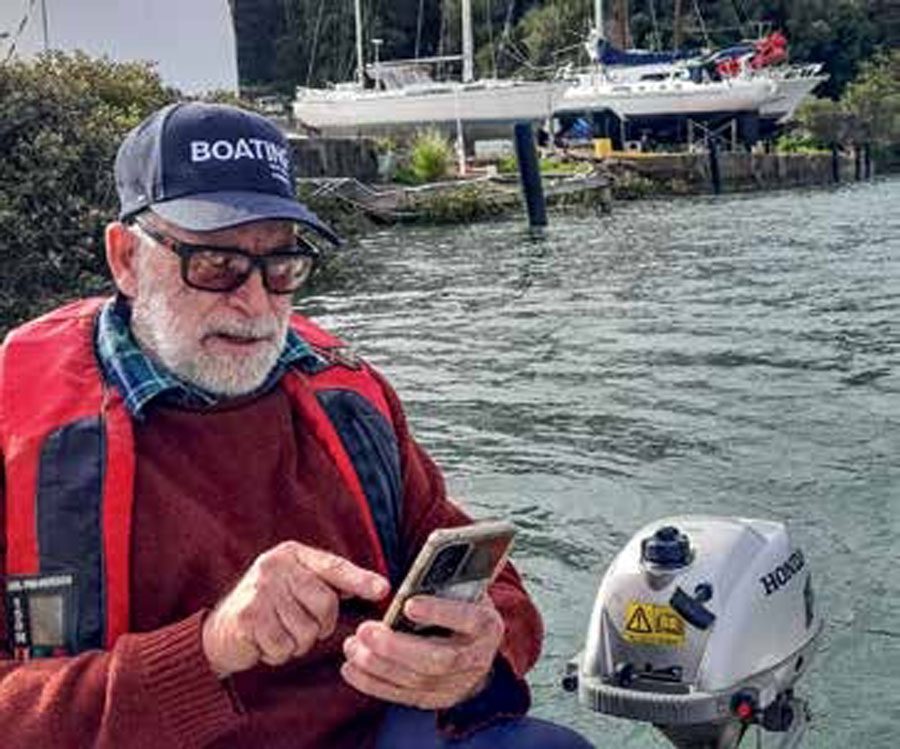
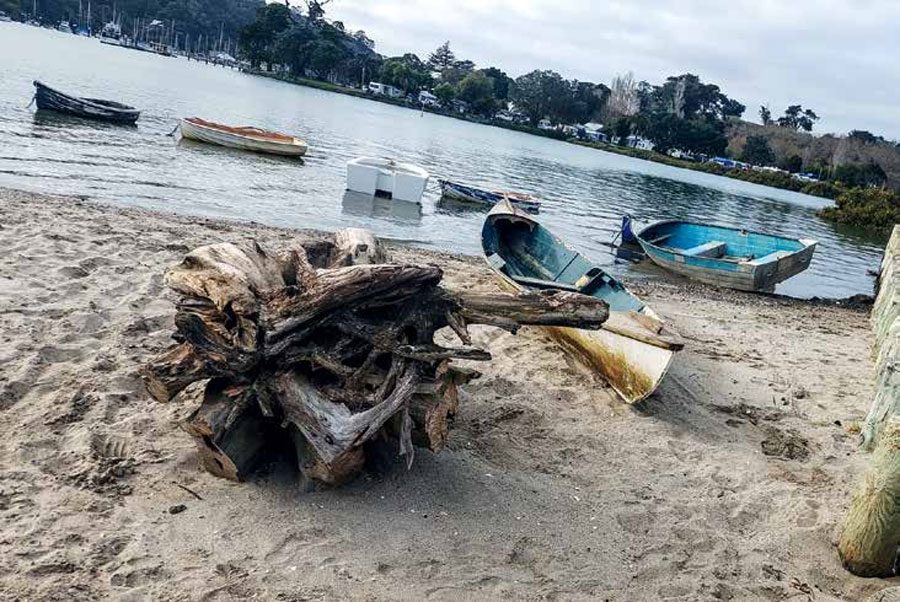
Andrew Weatherspoon Thorburn and his family were the first Pakeha settlers in Stillwater, arriving in 1852. Part of their original farm is now the reserve and memorial park. Other prominent early settler families included the Dacres, Percys, Blackshaws, and McPike brothers.
The McPike brothers subdivided their farm in 1950 to form what is Stillwater today. The motor camp was developed soon after the Second World War, connected to East Coast Road by a new road. Before this, there was only a farm track to Stillwater with a ford crossing at Doctor’s Creek.
Navigation into the mouth of the river required a wee bit of caution to get over a shallow spot just opposite Karepiro Bay and Dacre Cottage, but the channel markers led us safely closer to the northern-side promontory Wade Head. Yellow buoys off Long and Karepiro Bays, separated by Piripiri Point, are markers for the Long Bay Marine Reserve.
Just inside the heads, there are people wandering along the beach exposed by the lowish-tide. Father and young daughter on his shoulders wave at us. Greybeard in a sea kayak passes us, heading un-hurriedly out to Karepiro Bay. A traditional wee launch hurries ahead of us, sure of his draft and the water under him.
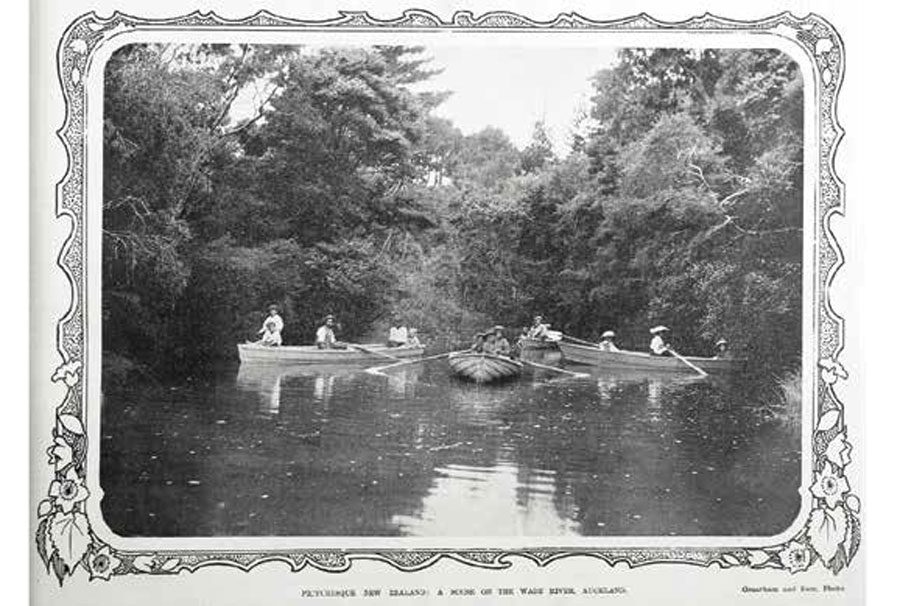

THE BOATING CLUBS
On the right are the fine premises – clubhouse, slipway, boatyard and 167 pile moorings in three rows – of the Weiti Boating Club. Tony and I, critical aficionados of good-looking boats, are impressed: these folk have fine tastes, with an inordinate number of beautifully maintained Townson yachts on show, plus interesting schooners and multihulls. (The theme of these last two continues up the creek). A far cry from the hard yakka of a few volunteers who started the club in 1968 with just a shed and a caravan on shore. One of the locals, Raymond Fussell, made a cool aerial video of what’s to see here (scan the QR code in the Further Info panel to view).
We headed further up. I had phoned ahead to Aaron Fitness, the yard-master at Stillwater Boating Club on the SW bank to get the gen. He checked no members would be using the boating club wharf and called back to offer us overnight berthing at a very reasonable rate. Which alleviated a concern for me, as my prior desktop investigation pointed to what could be a tricky and confined anchorage in an obviously strong tidal stream. You can also book that jetty space online – see info box.
Stillwater Boating Club was established by the local community over 50 years ago and remains the only club (with clubhouse) in Stillwater. The grounds are leased from the council and the club house and boatyard facilities are owned and managed by the club.
The boat ramp was built by volunteer members’ labour back in 1986. But in 2016 it was replaced and upgraded by Auckland Council, giving access to an all-tide launching facility.


The club’s boat yard also has storage facilities for dinghies, with haul-out capabilities and hardstand areas for maintenance work. Boat trailer parking is available to club members only.
Says its club website: “The clubhouse offers bar and meal facilities, we run social events and fishing competition throughout the season – we have some great times!” We can vouch for that, eh?
In the end, I believe we could have anchored safely further up the creek beyond Hibiscus Marine and Storage, perhaps with fore-and-aft lines for added security. But then we would have missed out on the hospitality offered by the club. When Tony and I popped in to pay our respects (and our mooring fee), we were immediately greeted by stalwarts of the club, commodore Steve Sharp and virtuoso boat coatings specialist Jason Sagar, who does most of his work in the yard there.
It happened to be the night of an epic Warriors semifinal NRL match – the one they won so convincingly. Club members glued to the big screen. It was thirsty work following the fortunes of our heroes of the night – ‘Up the Wahs!’ – and Tony and I did our best to keep up. Naturally the talk reverted to boats, before, at half-time, and after the match. And fine food. A perfect combination!
Nek mornin’ Tony and I took the tide to the top of the creek. Fortunately the timing was sympathetic for us, at polite hours after breakfast. We puttered up in the rubber dinghy, stopping for frequent (and quirky) photoshoots. But first, just north of the club on the side of Doctor’s Creek, the massive earthworks in preparation for the huge O Mahurangi-Penlink Bridge. It will be a work of civil engineering art, to be sure. With enough clearance for 60ft yacht masts to pass underneath. But it will turn the Stillwater basin into a viewing auditorium. The creek will be changed forever. There’s a rumour that the old-style waterfront motor camp just downstream of Stillwater Boating Club is to be re-developed on raised infill land to become flash apartments.
But in keeping with the current atmosphere, the bach just by the earthworks for the bridge has a coupla goats grazing quietly. A few jetties here are more than rickety. There’s a fellow working on the deck of another fine schooner. A boat moored midstream, festooned with flags.
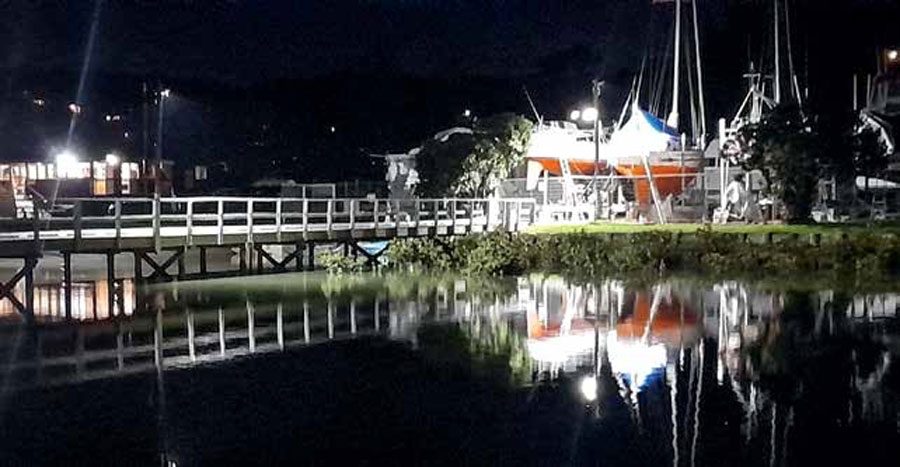

Some notes from a local, Dougall Burfoot (from an article in the NZ Herald):
With limited eating out options, a midweek lunch date can often mean loading up the double kayak with my wife, Michelle, Rocky the cocker spaniel, and taking a hamper of food for the 40-minute kayak to Dacre Cottage at Karepiro Bay.
I am inspired by Stillwater’s old world feel, its tranquillity, and its silence. The type of silence you notice, pierced only by birdsong, the bark of a dog or the laughter of people. When people discover Stillwater, they tend to stay for the long haul although we think the secret may be out, as the number of BMWs and Audis cruising our streets is slowly increasing and there are rumblings in the hills behind us from big developers.
SAVVY NAVVY AND MORE PHOTOS
Our continued testing of the Savvy Navvy app was also an appropriate combination. Checking it in very-well-known waters (for Tony and me, the passage from Waiheke Island, past Rakino and Motutapu towards Whangaparāoa); and using it in places completely unknown to us (the upper reaches of the Weiti River).
In both instances, we found it user-friendly and faultless, and just like in the upper Kaipara on my last Up the Creek adventure, we marvelled how much info the nautical charts still provided far inland. The speed across the ground feature was especially useful with us being otherwise instrument-free in the small rubber dinghy. I found it a bit awkward shifting from picture-taking mode with the smartphone, back to Savvy Navvy navigation – but that I’ll put down to finger trouble from the simple farm boy. Otherwise and overall, a top-rate app!
The creek provides us with more great scenes to photograph: interesting boats of all kinds, including a big and powerful aluminium ocean-cruising yacht that needs rescuing (Tony and I locked in discussion, agreed it’s save-able right now, but for not much longer); the boats worth looking at on the hard at Hibiscus Marine and Storage; a simple container-shed-based rowing club; a launch sunken up to its eyeballs; a red-rusting shipwreck just by Te Herenga o Orewa marae; full-colour ‘grouse bomb’ graffiti art down at mangrove mud level on the pylons of the Silverdale bridge that carries the Hibiscus Coast Highway.
From this point it would be a very short walk to the historic Wade Bar and Bistro – if we could find a place to scramble up the riverbank. Maybe they should offer a jetty for boatie visitors like us, eh?
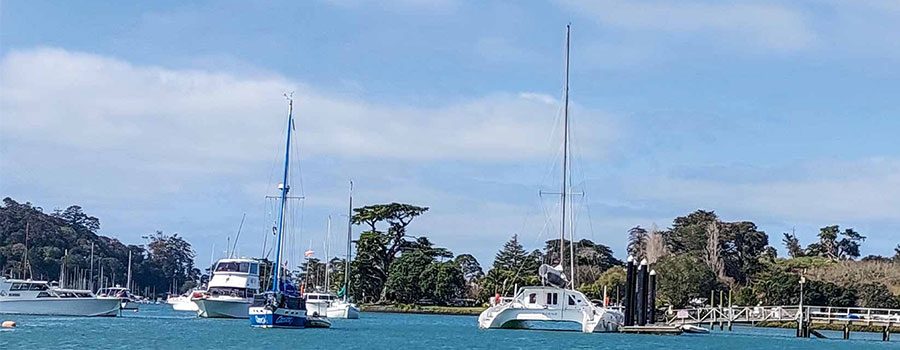
HEADING HOME
Downriver with the tide and our wee rubber dinghy going much faster than it should. Leaving the dock at Stillwater, we worried about that tide sweeping us onto a boat tied up in front of us, but no matter, Skyborne swings sweetly and clear away.
We have the best sail home, continuing our ongoing who-canmake-the-best-snacks competition. Tony wins hands down. Fine by me. We are so relaxed from our time at Stillwater that even in perfect conditions we can’t be bothered to hoist the gennaker.
We must go back. Stillwater can teach me a lot about relaxing. And I need that; we all do. BNZ




